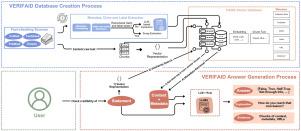The blueprint of a new fact-checking system: A methodology to enrich RAG systems with new generated datasets
IF 4.9
3区 计算机科学
Q1 COMPUTER SCIENCE, HARDWARE & ARCHITECTURE
引用次数: 0
Abstract
In an era where digital misinformation spreads rapidly, Artificial Intelligence (AI) has become a crucial tool for fact-checking. However, the effectiveness of AI in this domain is often limited by the availability of high-quality and scalable datasets to train and guide algorithms. In this paper, we introduce VERIFAID (VERIfication FAISS-based framework for fake news Detection), a novel framework that improves fact-checking through a Retrieval-Augmented Generation (RAG) system based on automatically generated and dynamically growing datasets. Our approach improves evidence retrieval by building a scalable knowledge base, reducing the reliance on manually annotated data. The system consists of three key modules: two dedicated to dataset creation and one inference module that integrates advanced language models, such as LLaMA, within the RAG paradigm. To validate our methodology, we provide technical specifications for both the system and the dataset, together with comprehensive evaluations in zero-shot fact-checking scenarios. The results demonstrate the efficiency and adaptability of our approach and its potential to improve AI-driven fact verification at scale.

新的事实核查系统的蓝图:用新生成的数据集丰富RAG系统的方法
在数字错误信息迅速传播的时代,人工智能(AI)已成为事实核查的重要工具。然而,人工智能在这一领域的有效性往往受到高质量和可扩展数据集的可用性的限制,以训练和指导算法。在本文中,我们介绍了VERIFAID(基于验证faiss的假新闻检测框架),这是一个通过基于自动生成和动态增长数据集的检索增强生成(RAG)系统改进事实检查的新框架。我们的方法通过建立一个可扩展的知识库来改进证据检索,减少对手动注释数据的依赖。该系统由三个关键模块组成:两个专用于数据集创建,一个推理模块集成了RAG范式中的高级语言模型,如LLaMA。为了验证我们的方法,我们提供了系统和数据集的技术规范,以及零射击事实核查场景中的综合评估。结果证明了我们的方法的效率和适应性,以及它在大规模改进人工智能驱动的事实验证方面的潜力。
本文章由计算机程序翻译,如有差异,请以英文原文为准。
求助全文
约1分钟内获得全文
求助全文
来源期刊

Computers & Electrical Engineering
工程技术-工程:电子与电气
CiteScore
9.20
自引率
7.00%
发文量
661
审稿时长
47 days
期刊介绍:
The impact of computers has nowhere been more revolutionary than in electrical engineering. The design, analysis, and operation of electrical and electronic systems are now dominated by computers, a transformation that has been motivated by the natural ease of interface between computers and electrical systems, and the promise of spectacular improvements in speed and efficiency.
Published since 1973, Computers & Electrical Engineering provides rapid publication of topical research into the integration of computer technology and computational techniques with electrical and electronic systems. The journal publishes papers featuring novel implementations of computers and computational techniques in areas like signal and image processing, high-performance computing, parallel processing, and communications. Special attention will be paid to papers describing innovative architectures, algorithms, and software tools.
 求助内容:
求助内容: 应助结果提醒方式:
应助结果提醒方式:


